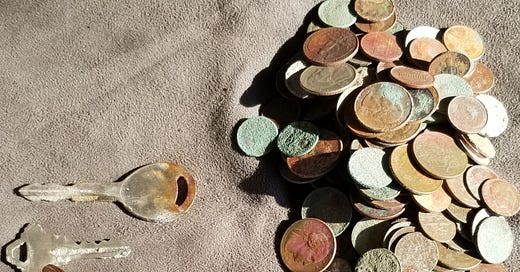While most of my detecting is done in the state of Pennsylvania, I occasionally visit other states. It’s been my tradition to visit Wildwood, NJ every fall for the past decade during the off-season. Generally, this happens in late October or November, but occasionally it’s as late as February. I’ve never found jewelry, other than cheap costume junk, but there are always a lot of coins, especially zinc pennies. Up until 1982, the formula for making pennies was a composition of 95% copper and 5% tin and zinc. After 1982, this was changed to copper-plated zinc. The core is 99.2% zinc, and .8% copper, with a paper-thin plating of pure copper. Zinc is particularly susceptible to the salt-water environment (or any water-based environment), and these pennies are generally far too corroded and/or encrusted to be useable, as shown below. Many detectorists don’t keep them, so they might be “found” many times before someone takes them off the beach.
In 1903, Wildwood built its first boardwalk directly on the beach. This boardwalk was only 150 yards long, and in 1905 the city voted to build an elevated boardwalk slightly closer to the ocean. Now the boardwalk stretches for nearly 2.5 miles and encompasses all of the Wildwoods (North Wildwood, Wildwood Crest, West Wildwood, Wildwood, and Diamond Head). While the boardwalk was once next to the ocean, it is now several hundred yards from the water due to the construction of Cape May’s harbor and jetties and the inlet at Wildwood Crest, giving beachgoers and detectorists much more open space. All this construction has changed the water’s flow and ebb, causing beach buildup, which is not necessarily a bad thing for Wildwood as it helps increase tourism by increasing available beach space.
While the ocean is a good distance from the water, my experience has been that most of my good finds are within perhaps 50 yards of the boardwalk. I don’t know if this is because the sand is softer there, allowing heavier weight items like coins and jewelry to be covered quickly, and therefore difficult for people to find, or whether more detectorists simply spend most of their time closer to the water where more people lay out their beach towels and umbrellas. Also, the harder sand near the water allows people to see dropped items before they are covered by sand, and for items that are not immediately found to be washed out by the tide.
On my trip to Wildwood in 2019, I managed somehow to find a 1941 Mercury dime, which piqued my curiosity as to how an 80-year-old coin was still around. Public beaches are always heavily hunted by detectorists all year round (but especially in the summer and fall), so finding anything of interest is a remarkable accomplishment.
This last trip was extremely satisfying as I found six silver coins, including a 1905 Barber dime (sadly, not an O-mint mark) , as well as two Mercury dimes, two silver Roosevelt dimes, and a silver Washington quarter. If you’ve been following my posts, you’ll remember that silver dimes and quarters ceased production after 1964, and silver half dollars after 1970. Considering how heavily worked public beaches are, it makes me wonder how a 1905 coin could still be lurking at a beach that is so heavily worked by detectorists. Closer to the water, machine dragging is done every morning during the beach season (late May through September), in order to collect most of the trash left by inconsiderate beach goers, but that can’t explain why all of these silver coins are still found in the loose sand closer to the boardwalk.
I also found several wheat pennies, which were last minted in 1958, so they’ve been overlooked by other detectorists as well.
My total haul for the three days was 29 quarters, 62 dimes, 12 nickels, 58 pennies, totaling $14.63—certainly not enough for a Red Lobster meal, even if I were inclined to spend it all. Looking forward to my next trip.








So cool! Sorry you didn't find enough for a Red Lobster meal! I do love the idea of you trying to pay your bill with crusty old pennies though.